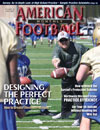Article CategoriesAFM Magazine
|
Lineal Speed with Velocity Changes - A Necessary Football Acquisitionby: Dale BaskettFootball Speed Specialist © More from this issue Lineal speed has a value to football speed. In fact learning to run properly for football speed must begin with lineal work. Once the lineal performance is sound then you can begin displacing momentum for football speed requirements. Lineal speed can be applied in certain ways on every play. When coaches look at lineal sprint speed they think of longer distances at maximum velocity rather than shorter bursts of acceleration. To reach maximum velocity it takes 40 - 50 yards for most young athletes. For elite athletes who can sprint well, it will take 55 - 70 yards. Lineal in football is usually channeled to the forty measurement. It’s not a flawless measurement by any means since the short distance doesn’t allow for maximum speed capacity. It does, however, provide timed speed comparisons to one another, and numerous years of testin....The full article can only be seen by subscribers.
|
|
|||||||
| HOME |
MAGAZINE |
SUBSCRIBE | ONLINE COLUMNISTS | COACHING VIDEOS |
Copyright 2026, AmericanFootballMonthly.com
All Rights Reserved





